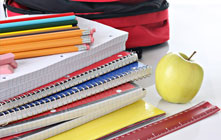Ways Students with Learning Disabilities Can Learn Better
Many students with learning disabilities struggle in school; however, there are specific techniques that you can use at home to help your child learn better. Keep reading to learn more about what you can do to improve your child's learning experience.

Suggestions to Help Students with Disabilities Learn Better
Preferential Seating
Depending on the disability some students have, where they sit in the classroom can play a major part in their overall success or lack thereof. In general, sitting close to the teacher will help these students because they are closer to the instruction and removed from distractions or students who may be bad influences. Discuss seating options with your child's teacher to ensure he or she is sitting in a place that will benefit him or her. Depending on the situation, it may also be a good idea to ask your child about his or her seat preference and relay this information to the teacher.
Work in Small Groups
You may want to ask the teacher if your child can work with others on some assignments. Alternatively, encourage your student to participate in after school clubs and activities.
Many students who have disabilities need help on assignments. Working in small groups allows them to get the help they need from their peers without feeling singled out. Furthermore, children with disabilities sometimes struggle to make friends in school, which can also play a part in how they perform in class. Working in small groups gives these students an opportunity to socialize with their peers. When students feel a sense of belonging, they tend to develop a better attitude about school in general, and that can help them focus more in class.
Break It Down
Students with disabilities are also able to learn better when lessons are broken down into more manageable steps. Many teachers already do this, but you may want to review the material with your child at home and present it in a simple, systematic way. Be sure your child understands each step before proceeding to the next.
Differentiate Instruction
When teachers differentiate instruction, they vary how they deliver information in order to accommodate the many ways students learn. This is especially beneficial for students with disabilities, because often their disabilities incline them to respond better to different types of teaching methods. In general, there are three main kinds of learning styles: auditory, visual and tactile/kinesthetic. Some students do best when classroom material is presented using a mix of all these styles. Once you determine the way your child learns best, it's a good idea to re-teach the material at home using the method that's most effective for your child's individual needs.
Other Articles You May Be Interested In
-
Children's Learning Disabilities: What Are They and How Do You Help your Child

Children with learning disabilities need some help to learn and retain concepts in reading, math, science, and other subjectx they take in school. You can help your child by getting informed and learning about learning disabilities and how they are treated.
-
Learning Disabilities and the College Admissions Process

A student with learning disabilities wants to go to college for the same reasons that motivate traditionally equipped students. This article can help learning disabled students with the often difficult college admissions process.
We Found 7 Tutors You Might Be Interested In
Huntington Learning

- What Huntington Learning offers:
- Online and in-center tutoring
- One on one tutoring
- Every Huntington tutor is certified and trained extensively on the most effective teaching methods
K12

- What K12 offers:
- Online tutoring
- Has a strong and effective partnership with public and private schools
- AdvancED-accredited corporation meeting the highest standards of educational management
Kaplan Kids

- What Kaplan Kids offers:
- Online tutoring
- Customized learning plans
- Real-Time Progress Reports track your child's progress
Kumon

- What Kumon offers:
- In-center tutoring
- Individualized programs for your child
- Helps your child develop the skills and study habits needed to improve their academic performance
Sylvan Learning

- What Sylvan Learning offers:
- Online and in-center tutoring
- Sylvan tutors are certified teachers who provide personalized instruction
- Regular assessment and progress reports
Tutor Doctor

- What Tutor Doctor offers:
- In-Home tutoring
- One on one attention by the tutor
- Develops personlized programs by working with your child's existing homework
TutorVista

- What TutorVista offers:
- Online tutoring
- Student works one-on-one with a professional tutor
- Using the virtual whiteboard workspace to share problems, solutions and explanations